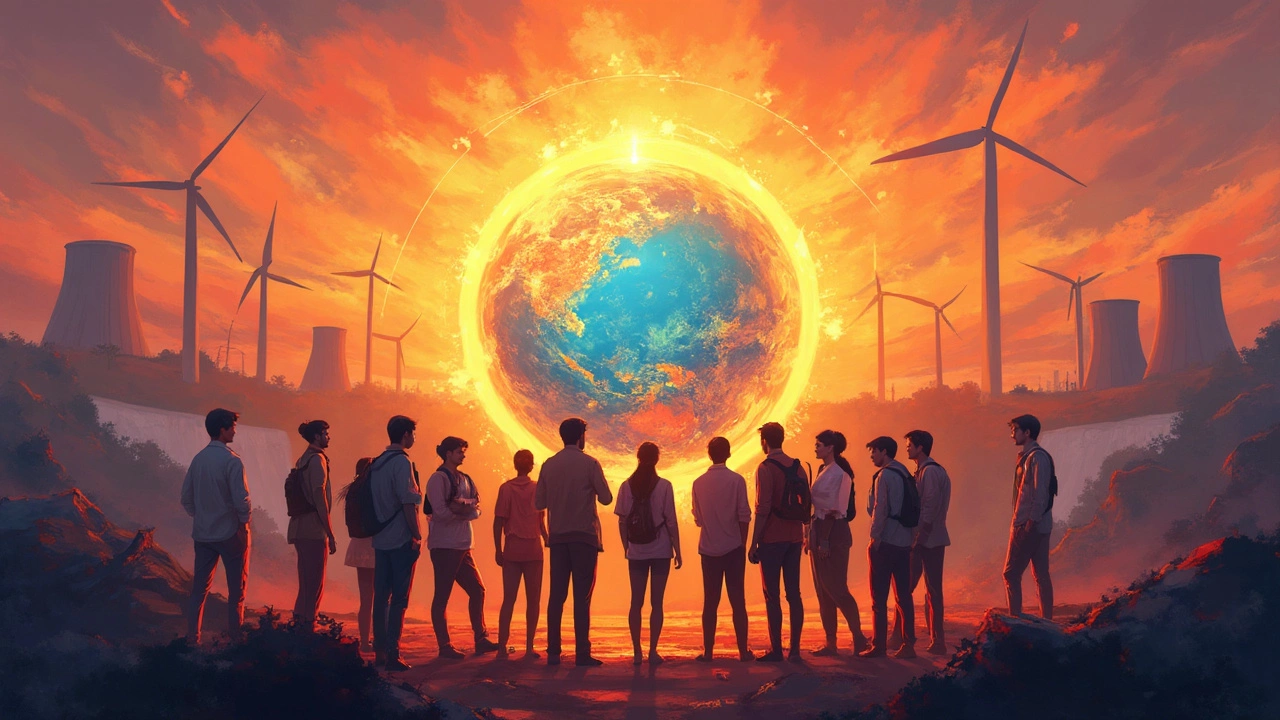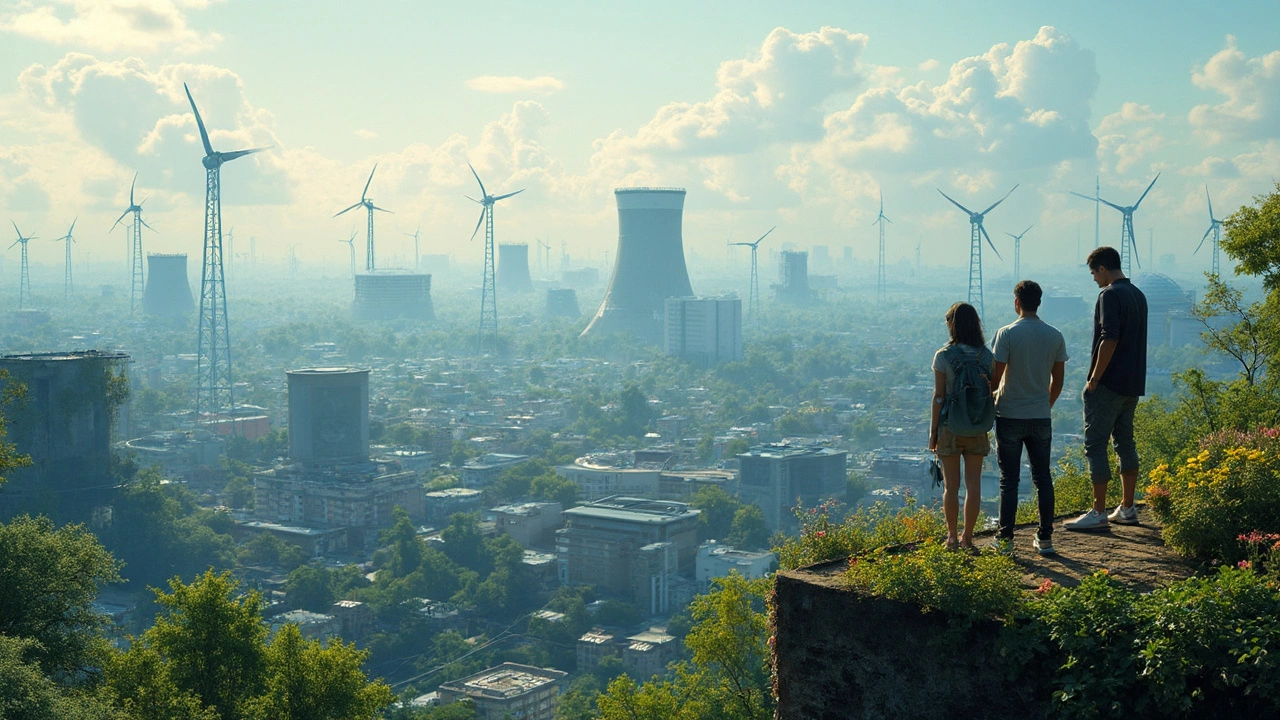Most Powerful Energy Source: Is Renewable The Winner?
 Jun, 10 2025
Jun, 10 2025
Ever wondered which energy source could actually run your city—or even the whole planet? People throw around terms like 'renewable,' 'green,' or 'clean,' but when you dig in, the real question is: what does 'most powerful' even mean when we talk about energy?
Here's a fun fact—every hour, the sun beams more energy onto Earth than everyone uses in a whole year. Wild, right? But there's a catch: harnessing all that power isn't as easy as soaking up some rays on your rooftop. So, is solar really the heavyweight champ? Or does nuclear have a better shot because of its crazy energy density? And we can't ignore wind and hydro, which quietly fuel whole countries when conditions are right.
Nailing down the 'most powerful' energy source isn't as simple as picking the one with the highest numbers. You gotta look at how much energy you can actually use after generation, how fast it scales up, and what hurdles get in the way. Stick around and you’ll see how the supposed powerhouses compare—not just in labs, but in the real world, where weather isn’t always perfect and storage matters more than you think.
- Defining 'Powerful' in Energy Terms
- The Top Contenders: Solar, Wind, Hydro, and Nuclear
- Crunching the Numbers: Efficiency and Scale
- Real-World Impact and Limitations
- What the Future Might Hold
Defining 'Powerful' in Energy Terms
So, what actually makes an energy source powerful? It's not just about cranking out huge numbers of kilowatts. You have to look at what matters: how much energy you get out, how fast you can access it, and how practical it is for everyday use. That brings us to a few basics you'll hear tossed around a lot—energy density, capacity factor, and scalability.
Energy density is the big deal here. That’s basically how much energy you can get from a certain amount of stuff. Think of it like comparing a tank full of gasoline to a car battery—it’s way easier to fill your car with power if the energy is packed in tight, like with nuclear fuel compared to solar panels.
Next up is capacity factor. This is a measure of how often a power plant actually pumps out all it can. Most solar farms, even in sunny places, hit about 20-25% of their max, because it’s not sunny all the time. Nuclear plants, wild as it sounds, can reach above 90% because they're running 24/7—unless they’re shut down for maintenance.
"People think the most powerful energy source is just about raw output, but reliability and scalability are what truly change the game." — Dr. Amory Lovins, Rocky Mountain Institute
Then there’s scalability: can you ramp this thing up to power a city, not just a single house? Big hydro dams have done it for decades, but you can’t put a river everywhere. Even wind farms need huge open spaces and strong, steady wind.
Here's a quick look at how the main energy types compare on these features:
| Energy Source | Energy Density (MJ/kg) | Capacity Factor (%) |
|---|---|---|
| Nuclear | 80,620,000 | 90 |
| Coal | 24 | 40-70 |
| Natural Gas | 55 | 40-60 |
| Hydropower | 1.5 | 35-50 |
| Wind | 0.05 | 30-45 |
| Solar PV | 0.2 | 20-25 |
Bottom line: the most powerful energy source isn’t just the one with the highest peak output. It’s about what delivers steady, reliable, and scalable power when real people need it.
The Top Contenders: Solar, Wind, Hydro, and Nuclear
If you’re asking what packs the most punch in the energy world, four names top the list: solar, wind, hydro, and nuclear. Each brings something unique to the table. Let’s break them down and see how they really stack up.
Solar power grabs attention because it’s everywhere—literally. Large solar farms in places like the Mojave Desert are turning sunlight straight into electricity for hundreds of thousands of homes. Average solar panels today convert about 22% of sunlight into usable energy, which might sound low, but the sun isn’t sending anyone a bill. In June 2024, solar made up about 7% of U.S. electricity production. Upside? No moving parts and barely any emissions. Downside? Solar takes up a lot of space and fades on cloudy days or at night.
Next, there’s wind energy. Ever driven past those giant turbines spinning in open fields? The largest wind turbines can power thousands of homes each. In Denmark, wind often supplies over 40% of national electricity. Wind works great in the right spots, especially offshore. But when the wind stops, everything pauses—unless there’s backup energy stored somewhere.
Hydro power is old school, but it’s still the world’s biggest source of renewable electricity. Think of massive dams like China’s Three Gorges, which can pump out more power than dozens of nuclear plants combined: up to 22,500 megawatts. The kicker? Building big dams means permanently changing local ecosystems and sometimes displacing whole communities. Yet, hydro is reliable if you’ve got the rivers for it.
Now for nuclear. Nothing beats it for pure muscle per square meter. A single nuclear power plant can produce gigawatts around the clock, rain or shine. While people worry about accidents or the long life of nuclear waste, the tech today is safer than the old school stuff from the 1980s. Plus, nuclear plants have tiny carbon footprints and they’re always on. But they’re expensive to build, regulators don’t make it easy, and public trust is a real issue.
Here’s a side-by-side look:
| Source | Capacity Factor* | CO2 Emissions (g/kWh) | Land Use (km2/TWh) |
|---|---|---|---|
| Solar | ~25% | 45 | 8 |
| Wind | ~35% | 11 | 1.3 |
| Hydro | ~45% | 24 | 0.6 |
| Nuclear | ~93% | 12 | 0.3 |
*Capacity factor means how often the plant is actually making electricity at max output, averaged across the year.
Different countries lean heavily on different sources depending on their geography, policy, and cash. The real power player is the one that fits the local mix the best—and gives the most bang for the buck when you need it.

Crunching the Numbers: Efficiency and Scale
When people argue about the "most powerful energy source," they usually mean the one that gives the most usable energy for the least trouble. Here’s where things get practical—how much bang do you get for your buck, square meter, or effort?
Let’s break it down:
- Solar power: The sun dumps about 173,000 terawatts of energy on Earth, nonstop. But solar panels usually turn only 15-22% of that sunlight into electricity. Not bad, but it takes a bunch of panels (and space) to make serious amounts of power. Solar’s top score? Big flexibility. You can stick panels almost anywhere.
- Wind power: Modern wind turbines hit about 35-45% efficiency, which means a decent chunk of the wind gets turned into usable juice. Offshore wind parks crank out more because there’s less blockage, but building them is pricey and takes time.
- Hydro power: Water dams are champs here. Some hit 90% efficiency because moving water is super predictable. But you need a big river, and, if you don’t live near one, you’re out of luck. There’s a reason hydropower’s already keeping the lights on in places like Norway and Quebec.
- Nuclear energy: This is the beast for pure power. One kilogram of uranium holds about 24,000 MWh of possible energy. Nuclear plants sit at 33-37% thermal efficiency, but they run all the time, day or night, sun or storm. The big draw? Bonkers energy density.
Here’s an easy-glance table with numbers that matter:
| Source | Typical Efficiency (%) | Power Density (W/m2) | World Share (%) |
|---|---|---|---|
| Solar | 15–22 | 10–20 | 6 |
| Wind | 35–45 | 1–2 | 7 |
| Hydro | 90 | 30–40 | 16 |
| Nuclear | 33–37 | 500–1,000 | ~10 |
So, where does the renewable energy debate really land for regular people? Solar is perfect for rooftops, wind shines in big open fields, hydro works wherever there’s a river, and nuclear keeps grids humming at scale. If you want big, reliable numbers and a small footprint, nuclear looks strong. But if flexibility or green creds matter, solar and wind win hearts, if not always headlines.
Real-World Impact and Limitations
On paper, the biggest energy sources look unstoppable. But it’s when they step into the real world—like how you use energy at home or how an entire country powers its grid—that their true strengths and weaknesses show up.
Let’s get real about renewable energy: solar parks and wind farms are popping up everywhere, but neither works well 24/7. A giant solar array in California can push out enough electricity for hundreds of thousands, but on a cloudy day, output plunges. Wind? Same thing—if there’s no breeze, those huge turbines just stand there. And you can’t ship sunlight from Texas to New York when clouds roll in. That’s why backup storage is so important and, to be honest, still pretty expensive right now.
Hydropower seems almost perfect—it generates a ton of electricity reliably, and Norway even gets 99% of its power from it. The limitation? You need rivers, huge dams, and a lot of land. In dry years or places without big rivers, hydro can’t deliver.
Nuclear is a weird one. Its biggest draw is energy density—a single plant can produce the kind of steady, massive power that can keep whole cities switched on, rain or shine. But then you’ve got long construction times (often more than ten years), the nuclear waste headache, and high upfront costs. There’s also public fear, usually because of past accidents. So it’s a political minefield too.
| Energy Source | Capacity Factor* (%) | Main Limitation |
|---|---|---|
| Solar (PV) | 22 | Works only with sunlight, storage needed |
| Wind | 35 | Needs steady wind, not always reliable |
| Hydro | 41 | Depends on river flow and geography |
| Nuclear | 93 | Expensive, slow build, waste issues |
*Capacity factor means the percentage of a plant's full capacity that it actually delivers over a year. Higher is better.
Here’s where things get interesting: every source has its own deal-breaking hurdle, so countries usually mix them up. If you live somewhere sunny and windy, you’ll see more solar panels and turbines. Near a big river? Hydro is king. France? Nuclear rules. The future is probably a patchwork, with tech improvements smoothing out some of the bigger headaches, like battery storage for renewables or safer reactors for nuclear.

What the Future Might Hold
Now for the million-dollar question—where are we actually headed with our hunt for the most powerful energy source? It’s looking like renewables and their tech upgrades are running the show, but there are some big twists on the horizon that could shake everything up.
For starters, the price of solar panels has dropped by about 90% since 2010. That’s not just a number—it’s the reason people in suburbs, big cities, and even out in the sticks are seeing solar as a real choice. Strong government support helps, too: over 130 countries have set targets for hitting net-zero emissions by 2050.
But here’s what’s even more interesting. Ever heard of perovskite solar cells? If regular panels are like dial-up, these things are broadband—in labs, they’re hitting efficiency numbers north of 30%. That could totally change the game, making renewable energy even more powerful and accessible than it already is.
Wind is also leveling up. New floating turbines let us stick wind farms farther out at sea, where breezes are stronger and complaints are basically zero. There’s also a push for battery tech—think super-sized lithium batteries or crazy ideas like gravity storage (where you use excess power to lift heavy blocks, then grab that energy back as they drop).
Let’s put some of these trends side by side so it’s easy to spot what’s growing, what’s fading, and what could break out big time:
| Technology | 2024 Capacity Growth | Predicted 2030 Capacity | Main Hurdle |
|---|---|---|---|
| Solar (PV) | ~295 GW/year | 5600 GW | Storage, space |
| Wind (on/offshore) | ~100 GW/year | 2300 GW | Transmission limits |
| Hydro | ~25 GW/year | 1500 GW | Geography, drought |
| Nuclear (new builds) | ~6 GW/year | 500 GW | Cost, public pushback |
The future’s not just about flipping one big switch—it's about mixing stuff that works differently. Microgrids can help towns make the most out of local wind and sun without tons of wires. There’s hope for hydrogen, too: if we can crack the code to make it clean and cheap, it's a solid way to store extra power or fuel heavy trucks and ships.
If you care about what powers your home (and honestly, your whole lifestyle), it’s worth keeping an eye on new breakthroughs. Watch how local policies shift, how fast battery prices drop, and whether the newest solar and wind tricks actually move off the drawing board. The reality? The most powerful source won’t be one single thing. It’ll be a smart combo, way bigger than the sum of its parts.